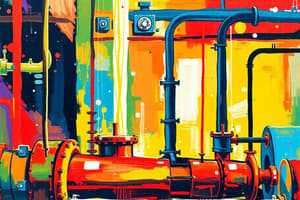Podcast
Questions and Answers
What stream does the overhead vapor from D-310A/B get scrubbed with in T-330?
What stream does the overhead vapor from D-310A/B get scrubbed with in T-330?
A C10-C12 stream from E-426.
What is the purpose of the Saturate Reduction System?
What is the purpose of the Saturate Reduction System?
To remove aluminum alkyl from the bottom liquid product stream.
What happens to the overhead vapor after it exits T-330?
What happens to the overhead vapor after it exits T-330?
It is routed to the shell side of E-330A/B for cooling.
After D-330, where does most of the vapor go?
After D-330, where does most of the vapor go?
What is the significance of the excess vapor from D-330?
What is the significance of the excess vapor from D-330?
What do the bottom liquid product streams from T-330 and D-330 get routed to?
What do the bottom liquid product streams from T-330 and D-330 get routed to?
What is a critical issue that aluminum alkyls may cause in downstream equipment?
What is a critical issue that aluminum alkyls may cause in downstream equipment?
How is the vapor from E-330A/B cooled?
How is the vapor from E-330A/B cooled?
What type of product stream is formed at the bottom of D-310A/B?
What type of product stream is formed at the bottom of D-310A/B?
What is the role of the C10-C12 stream in the TEA Scrubber?
What is the role of the C10-C12 stream in the TEA Scrubber?
Where is the overhead vapor from the TEA Scrubber directed after scrubbing?
Where is the overhead vapor from the TEA Scrubber directed after scrubbing?
What happens to any entrained liquid at D-330?
What happens to any entrained liquid at D-330?
What is the fate of most of the vapor after D-330?
What is the fate of most of the vapor after D-330?
What process removes aluminum alkyl from the bottom liquid product streams?
What process removes aluminum alkyl from the bottom liquid product streams?
What is the purpose of routing excess vapor from D-330 back to D-110?
What is the purpose of routing excess vapor from D-330 back to D-110?
What type of equipment is prone to issues due to the presence of aluminum alkyls?
What type of equipment is prone to issues due to the presence of aluminum alkyls?
Flashcards are hidden until you start studying
Study Notes
Reactor Effluent Processing
- Effluent exits through a common header and is directed to D-310A/B (Reactor Effluent Separators).
- D-310A/B separates the effluent into an overhead vapor recycle ethylene stream and a bottom liquid product stream containing NAO (Navigated Aqueous Organic) and catalyst.
TEA Scrubber Operations
- Overhead vapor ethylene stream is routed to T-330 (TEA Scrubber) for treatment.
- T-330 uses a C10-C12 stream from E-426 (C8 Tower Bottoms Cooler) to scrub vaporized or entrained aluminum alkyls, preventing ethylene polymerization and potential downstream plugging.
Saturate Reduction System
- Bottom liquid from D-310A/B is transferred to the Saturate Reduction System for aluminum alkyl removal.
Ethylene Recycling
- Overhead vapor from T-330 is cooled in E-330A/B (Ethylene Recycle Coolers) before proceeding to D-330 (H.P. Recycle Knock-out Drum).
- D-330 separates any entrained liquids from the vapor stream.
Vapor Stream Distribution
- The vapor from D-330 splits into two streams:
- Most is directed to E-373 (Purge Gas Heater) within the Deethenizer System.
- The excess vapor is recycled back to D-110 (Charge Gas Compressor Suction Drum) as recycled ethylene in the Ethylene Feed Section.
Caustic Wash Processing
- Bottom liquid product streams from both T-330 and D-330 are sent to T-340 (Caustic Wash Vapor Scrubber) for further processing.
Reactor Effluent Processing
- Effluent exits through a common header and is directed to D-310A/B (Reactor Effluent Separators).
- D-310A/B separates the effluent into an overhead vapor recycle ethylene stream and a bottom liquid product stream containing NAO (Navigated Aqueous Organic) and catalyst.
TEA Scrubber Operations
- Overhead vapor ethylene stream is routed to T-330 (TEA Scrubber) for treatment.
- T-330 uses a C10-C12 stream from E-426 (C8 Tower Bottoms Cooler) to scrub vaporized or entrained aluminum alkyls, preventing ethylene polymerization and potential downstream plugging.
Saturate Reduction System
- Bottom liquid from D-310A/B is transferred to the Saturate Reduction System for aluminum alkyl removal.
Ethylene Recycling
- Overhead vapor from T-330 is cooled in E-330A/B (Ethylene Recycle Coolers) before proceeding to D-330 (H.P. Recycle Knock-out Drum).
- D-330 separates any entrained liquids from the vapor stream.
Vapor Stream Distribution
- The vapor from D-330 splits into two streams:
- Most is directed to E-373 (Purge Gas Heater) within the Deethenizer System.
- The excess vapor is recycled back to D-110 (Charge Gas Compressor Suction Drum) as recycled ethylene in the Ethylene Feed Section.
Caustic Wash Processing
- Bottom liquid product streams from both T-330 and D-330 are sent to T-340 (Caustic Wash Vapor Scrubber) for further processing.
Studying That Suits You
Use AI to generate personalized quizzes and flashcards to suit your learning preferences.




